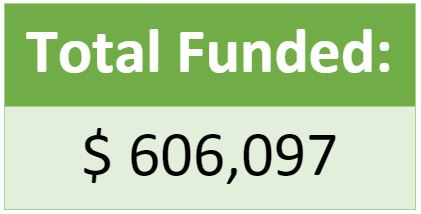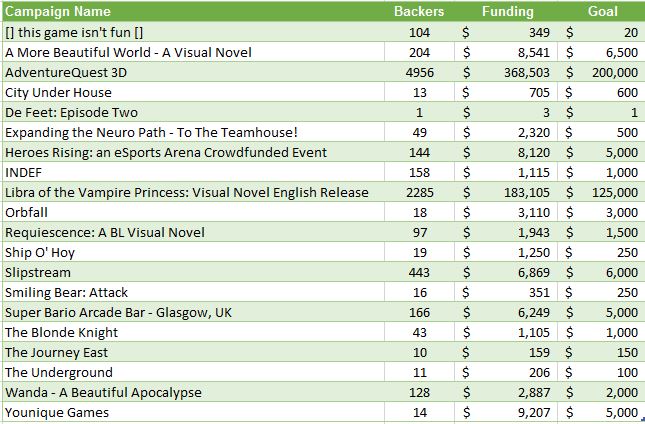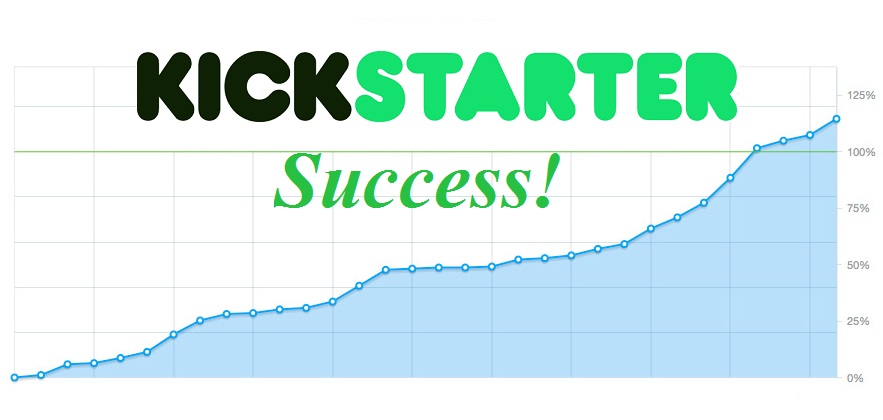Did you notice that we at Cliqist finally went forward with a plan that has been in the works for a long while now? After much consideration, we finally shared a massive Excel spreadsheet of Kickstarter video game data which is free for anybody and everybody to use. Not only is this collection of data incredibly interesting to look through, it is also a huge help for me and these data analysis posts. No longer will I be required to collect all these various points of information by hand! In fact, thanks to the spreadsheets automation abilities, it is able to grab far more bits of info that may end up being quite useful. What it lacks may also be added in as we begin working with this Excel sheet more and more. With all that said, I highly suggest those data-hungry folks out there to check the information out for yourself. This is the first analysis article of the year and is my first shot at working with the new data! Please forgive that, at least for this month, the data is focused purely on items within the “video games” category of Kickstarter.
Another change coming to these posts this year is that there will not always be five featured campaigns each and every time. Sure, having five gives a good look at the scope of crowdfunded successes for the month, but in some months it feels like a bit of a stretch. From now on my focus will be on highlighting those campaigns which I really like either for personal reasons or because they just seemed to get a lot right. Or, maybe they’re just super interesting and worth discussing briefly. Okay, on with the show!
Note: All non-US $ amounts have been converted to dollars based on exchange rates as of this writing.

Libra of the Vampire Princess (Previous Coverage)
Raised: $183,105
Days to Success: 35
Backers: 2,285
Yup, of course a visual novel has to be on the list. The amazing thing about Libra of the Vampire Princess’ success is that it managed to make nearly $200,000 without two factors that most highly successful genre titles on Kickstarter have: 1) Sekai Project did not have a hand in its creation and 2) It is not an existing franchise. This is a game that is in fact fairly new to Japan, and therefore doesn’t have a huge worldwide fanbase. Even so, MiKandi Japan managed to lure folks into Libra of the Vampire Princess. I admit I was one of the people to give into the shiny newness of this visual novel and MiKandi’s push for providing both an all-ages version and adult patch for those who prefer it.

Slipstream (Previous Coverage)
Raised: $6,869
Days to Success: 28
Backers: 443
Once upon a time, the concept of creating a racing game now with the aesthetics of arcade and console classics from the 80s/90s was unique. Amazingly, we’ve since seen multiple games of this type pop up (both on Kickstarter and outside of crowdfunding) and each has its own degree of awesomeness. Slipstream is the latest in this realm and looks pretty darn awesome. There’s also a demo available for folks to play whether running a Windows, Mac, or Linux machine. At times, I feel a bit silly for chasing after every retro-inspired racer, but hey, Slipstream succeeded easily so it means I’m not alone!

With the new year underway, we’re back to a more “normal” moment for Kickstarter, if there is such a thing. Not every month can be filled to the brim with campaign after campaign that demands your dollars. After all, there are most certainly those months of the year which draw more attention than others. After the slipping from December, January continued with a generally subdued amount of money raised with $606,097. This funding comes to us from twenty different video game campaigns which, for the most part, didn’t raise all that much money on their own. We’ll get to that in a second, though.
Of the month, the most successful project was AdventureQuest 3D with a total of $368,503 raised. I’ll admit right now that I do not fully understand why this game managed to generate so much funds, but maybe it’s just not the kind of game for me. What they explained and showcased just didn’t look all that innovative or exciting but obviously nearly 5,000 backers disagree with this viewpoint. Second on the list was visual novel Libra of the Vampire Princess. It’s definitely a proud moment to see a visual novel do so well on a monthly list, but really, the list wasn’t all that exciting this time around. Honestly, when things like [] this game isn’t fun [] raise over $300 then you know that people are just looking for something to throw their wallets at.
The average raised between all successful Kickstaters for January is $30,304. Of course, this includes our two excellently funded stars as well. It makes far more sense to remove those for an average since nothing else even managed to raise $10,000. So, with that taken care of the average between the majority of campaigns drops down to $3,027. Yep! It is honestly impressive what a low average January had as far as successful projects goes. Normally we tend to see numbers that at least gravitate somewhat around $15,000 but darn. If you look at the list of twenty projects (provided at the bottom of this article) then you’ll easily see why these projects were funded so tepidly. Many of the games simply didn’t look all that amazing at all.

Looking at the trends for days to funding reveals that things are still pretty much the same as always, even with a fair handful of less than stellar Kickstarter projects. Day 1 successes are still not super frequent anymore, with most finding their funding from the midpoint to last few days. It’s interesting (or sad) to note that [] this game isn’t fun[] accounts for one of the day 1 victories. Then again, they were only asking for $20 so that’s pretty easy to scrounge up. That over 31 days project was Libra of the Vampire Princess which featured a 40 day campaign length. As I’ve commented on before, and will continue to do so as long as people keep using extended lengths, don’t! A longer project does not increase the amount of funds received. Instead, it extends the length of time people have to fuss over the project and not back it, leaving campaign leads stressed for even longer periods of time just to receive the same funding result.
One potentially exciting factor is the fact that there were a fair share of global Kickstarters represented in the successful batch in January. At least, this is when we gauge based off of factors such as the campaign’s set currency type. Normally we see a heck of a lot of USD, some CAD, and potentially Pounds. Here is the breakdown for January in alphabetical order: AUD (2), EUR (1), GBP (3), NOK (1), SEK (1), USD (12). So while the United States (currency, at least) still dominates, we found a fair share of other projects to back as well. The biggest issue with simply using USD as a flag for the United States is that sometimes projects launch with a USD goal despite not actually originating from a team in this country. There’s nothing wrong with the tactic as it generally makes sense when you’re conducting business on a site predominantly visited by US consumers.

Checking on the backer counts reveals that there were not a ton of folks funding things this month. In total, just 8,879 backers max contributed to projects which ended up succeeding during January. As is so readily apparent from the bar graph above, the vast majority of these people were hitting up Kickstarter for one of two campaigns. With those out of the way, everyone was left fighting for scraps. Honestly, when nearly ten projects have less than twenty backers then you know that a heck of a lot of campaigns basically just squeaked by. The average backer per project count is 443.95 by default, but again, that includes our powerhouse projects of the month. Removing them from the calculation leaves us with an average of 91 backers per campaign. Not horrible, but definitely not super healthy if you’re expecting to raise $10,000 or more.
Here’s a fun little stat that we’re now gathering with the new data. When do you think that successful campaigns end during the week? I would have always assumed the weekend for the simple logic that it’s a better time to catch people having some downtime. However, that’s not completely the case. For the month of January, our successful projects ended on every day of the week except Wednesday. It went like this: Monday (3), Tuesday (5), Thursday (3), Friday (4), Saturday (2), Sunday (3). With that said, even if you can succeed any day of the week it’s probably still better to select your end date carefully.
There is always more information to generate from Kickstarter video game campaign data, but these are just the most notable tidbits to us. If you’d like to know something else (more specific to one campaign, or other stats) then please let us know in the comments with inquiries and suggestions. I’ve yet to gain mastery of all our new data, but hopefully some of it will create opportunities for unique avenues of coverage.
Here’s a look at each successful campaign in a handy table to get a glimpse at (a small sampling of) the information we gathered to make this post possible:




